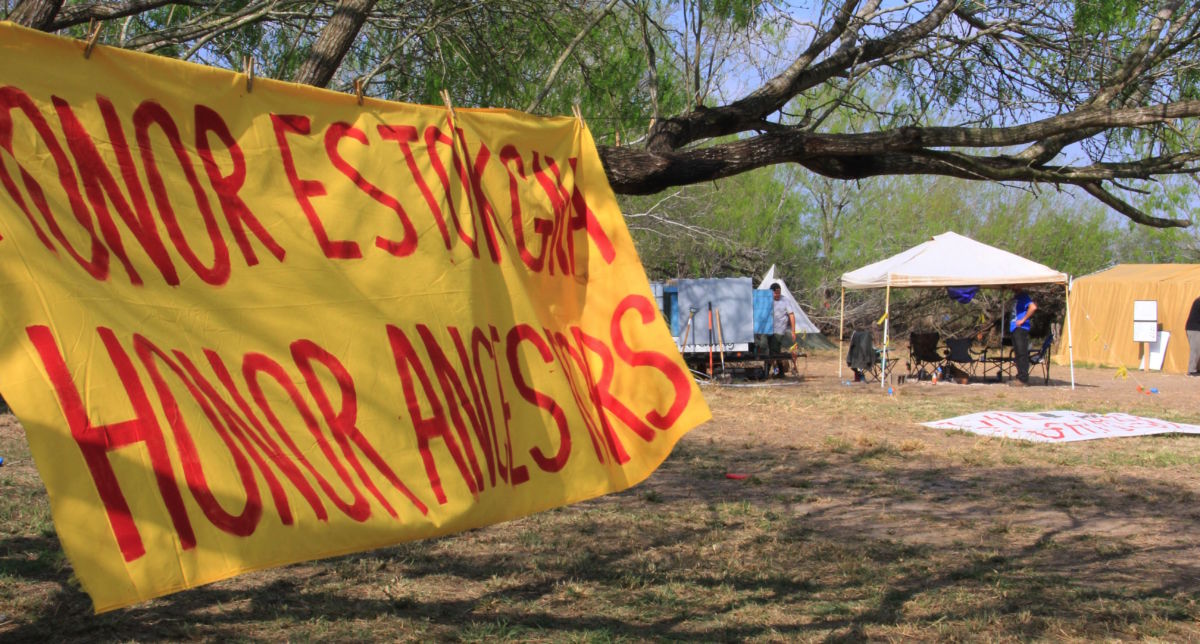Honest, paywall-free news is rare. Please support our boldly independent journalism with a donation of any size.
The 1,600-member Carrizo/Comecrudo tribe of South Texas knows no borders. Called the Esto’k Gna in their Native language, the tribe’s people have been aboriginal to both sides of the Rio Grande River for centuries, and have maintained sacred sites and burial grounds along its banks for just as long, but the tribe is not recognized by the state or federal government.
Tribal Chairman Juan Mancias tells Truthout that many of the tribe’s ancestors made efforts to anglicize during the 1800s as a means of surviving the violent colonization that is still shaping South Texas, and that many are now laid to rest under anglicized names at the 154-year-old Eli Jackson Cemetery just a mile north of the river in the border town of San Juan, Texas. Mancias says he is also a distant descendant of some of those laid to rest there.
The quarter-acre cemetery inters 150 South Texans, including Nathaniel Jackson, the white son of a plantation owner, and likely his wife, Matilda Hicks, an emancipated slave, who together founded a 5,500-acre ranch and community here with several other families. Just a short walk back up the road sits the Jackson Ranch Methodist Chapel and its separate cemetery. A small stone marker indicates the U.S.-Mexico boundary to the chapel’s right.
Just a few yards north of Eli Jackson’s headstones is a sloped earthen river levee where President Trump hopes to build one of the first sections of his border wall — a 14-mile stretch of concrete and steel fence, 30 feet tall. Congress gave Trump $1.6 billion to build this segment, among others in the Rio Grande Valley, in 2018.
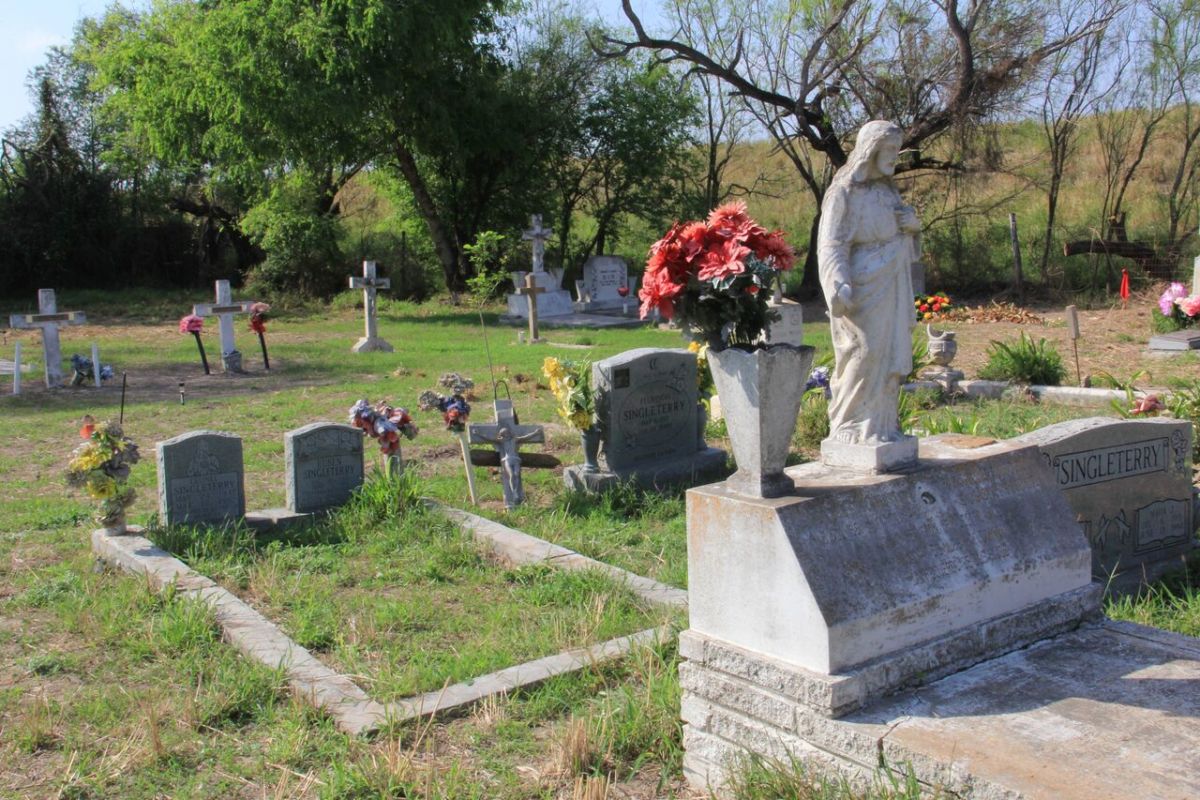
Once the fence goes up, U.S. Customs and Border Protection (CBP) officials plan to clear a 150-foot enforcement zone to the levee’s south. Even if the zone doesn’t necessitate razing the cemetery and exhuming bodies, which many here fear, it would almost certainly mean the public would be cut off from these registered historic landmarks.
That’s why Carrizo/Comecrudo tribal members, including some veterans of the Standing Rock protests, and their environmentalist allies, have cleared away the weeds from the headstones and pitched more than a dozen tents, vowing resistance to the president’s wall — including potentially engaging in civil disobedience to stop construction equipment from decimating the sacred sites. The tribe is already setting up two other camps along the border wall’s path, including one at the National Butterfly Center in Mission, Texas.
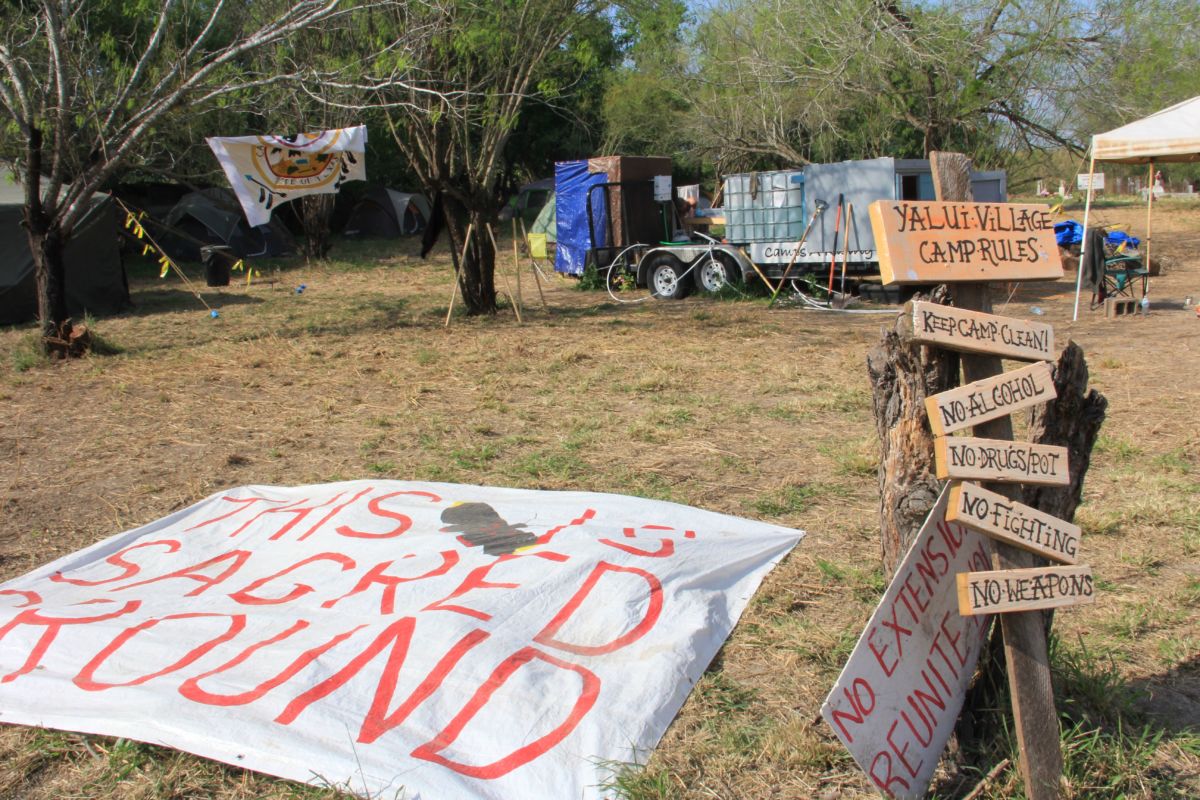
“We don’t own the land, nobody does. The land owns us as Indigenous people. That’s why we have an accountability to this land,” Mancias says. “Our direct action is that we exist.”
A Sacred History
Driving into the tribe’s new “Yalui” camp (“butterfly” in the Esto’k Gna language), you see rolling stretches of farmland checkered with natural gas drilling sites and pipeline compressor stations. Spring is in bloom here, and the camp’s namesake butterflies are stopping by to fan their wings across the headstones. Mockingbirds accompany tribal members’ ceremonial drumming in song. The camp’s peace is only broken by the occasional circling of Border Patrol vehicles.
Uncompromised, uncompromising news
Get reliable, independent news and commentary delivered to your inbox every day.
Sitting under the shade of a sugar hackberry tree, I listen to tribal member Christopher Basaldú explain how Nathaniel Jackson and Matilda Hicks shepherded enslaved people to freedom in Mexico as part of the Underground Railroad.
Jackson and Hicks originally intended to cross the border into Mexico, seeking protection from the racial terrorism of slavery that also outlawed their interracial marriage. The couple traveled to the border with their seven children and 11 other emancipated slaves from Alabama in 1857 but stopped short of actually crossing.
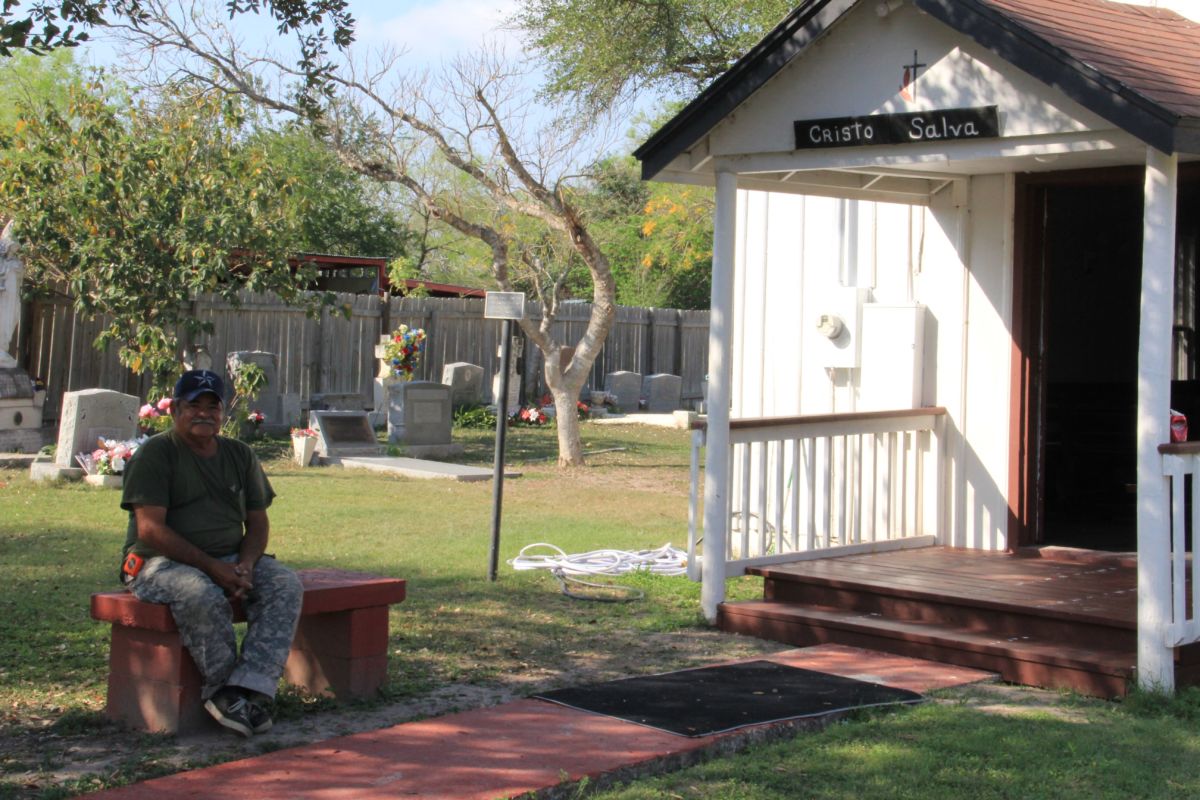
Instead, they fell in love with the land here and established a ranch, knowing they could quickly cross into Mexico if they needed to. Over time, the couple became known for helping enslaved people who had run away, many of whom stopped at the ranch to rest and resupply before ultimately reaching Mexico. Jackson offered runaways parcels of his own land, and some decided to lay down roots of their own under the protection of the newly formed community instead of crossing the border.
Today, Ramiro Ramírez, a fifth-generation descendant of the Jackson family, maintains the Jackson Ranch Chapel. He restored it after it sustained heavy flood damage from Hurricane Dolly in 2008. Both his father and grandmother are buried in the Jackson Ranch Cemetery, and his own plot will be next to them.
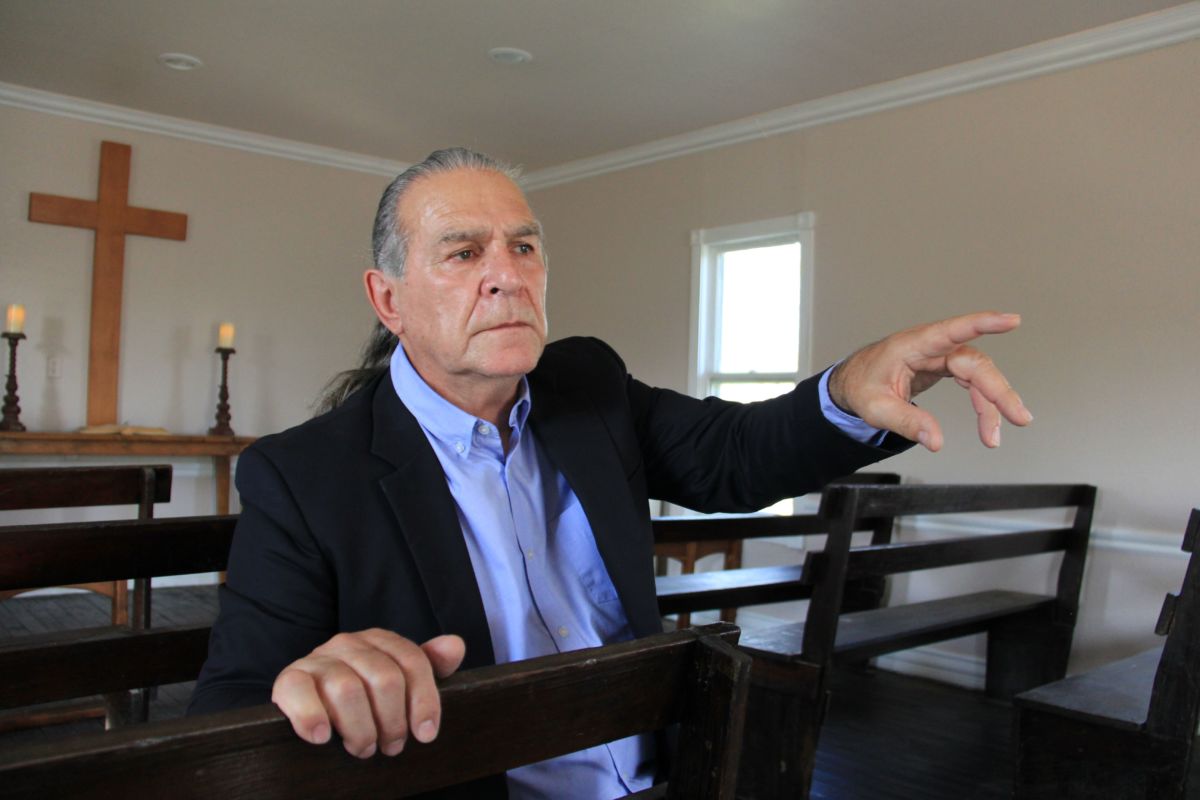
“It’s news that can’t be; that’s not going to happen. It won’t happen. We’re not going to let it happen,” Ramírez says about the possibility of the historic sites being razed for Trump’s new wall segment. “I will lock myself behind the doors. I will tie myself to a tree. I will tie myself to machinery. They’re not going to do it. We may be arrested, but they’re going to have to take us.”
“I will tie myself to machinery. They’re not going to do it. We may be arrested, but they’re going to have to take us.”
Regional CBP officials met with the Ramírez family last week, telling them that the agency has no plans to break ground at the Eli Jackson Cemetery for at least six months and that no bodies would be exhumed, according to Ramirez’s sister, Sylvia. Officials suggested that the Jackson Ranch Chapel and Cemetery, however, may already be a safe enough distance away from the levee. Still, the officials cautioned the family that there are “no guarantees” for either site, since more than 28 federal laws are being waived to expedite the wall’s construction.
The agency has placed survey flags at the edge of the chapel grounds, raising concerns that the property could become part of CBP’s enforcement zone. CBP officials told Sylvia, however, that the flags are meant to determine property boundaries and ownership, and do not necessarily mean the property must be condemned.
CBP did not return Truthout’s request for comment to confirm the timeline, or to clarify issues about how construction could affect the chapel and cemeteries.

Sylvia remains skeptical, telling Truthout that she doesn’t understand why her family’s land isn’t exempt from the new fence segment like other local historically and environmentally sensitive sites in the Rio Grande Valley.
Congress’s appropriations bill, signed by President Trump in February, barred federal funding for new fencing at five Valley sites, including the La Lomita Chapel, the National Butterfly Center, Bentsen-Rio Grande Valley State Park, the Santa Ana National Wildlife Refuge and a SpaceX-owned facility. It remains unclear, though, whether the congressional spending bill overrides the president’s recent emergency declaration. For now, construction equipment at the border sits idle.
The Ramírez family is considering filing a lawsuit against CBP. The family’s lawyer sent a detailed letter to CBP in November with the geographical coordinates of the cemeteries, warning that construction on the wall should not move forward without an exhaustive analysis.
Protections for Texas Tribes Routinely Ignored
The cemeteries are not the first sacred sites to be threatened in recent years by colonial machinery in the state. As Truthout has previously reported, Native cultural sites have also been destroyed by the very same company responsible for desecrating Indigenous graves at Standing Rock: Energy Transfer Partners.
The company set bulldozers to several historic and cultural sites to build its Trans-Pecos and “Comanche” Trail pipelines. Tribal groups later blockaded construction equipment to delay those projects in 2017. Native gravesites were also exhumed when mining began at the Dos Republicas Coal Partnership’s Eagle Pass Mine in 2015, despite outcry from tribes including the Carrizo/Comecrudo.
Native cultural sites have also been destroyed by the very same company responsible for desecrating Indigenous graves at Standing Rock: Energy Transfer Partners.
The desecrations are part of the reason why the tribe is working toward state and federal recognition, the latter allowing them protections under the 1990 Native American Graves Protection and Repatriation Act (NAGPRA) and section 106 of the 1966 National Historic Preservation Act. Still, many members are hesitant about the idea of becoming recognized by either by the state and federal government, saying that it isn’t for the government to determine whether they exist.
The state of Texas has only recognized the Lipan Apache and the Texas Band of Yaqui Indians, and only three federally recognized tribes reside in the state — all of whom were displaced from their aboriginal lands as a result of state-sponsored extermination campaigns and forced relocation.
“It’s an interesting irony that the people who are recognized, or who get the official stamp of approval for being Native to this area, are not the original people of this land,” Basaldú says.
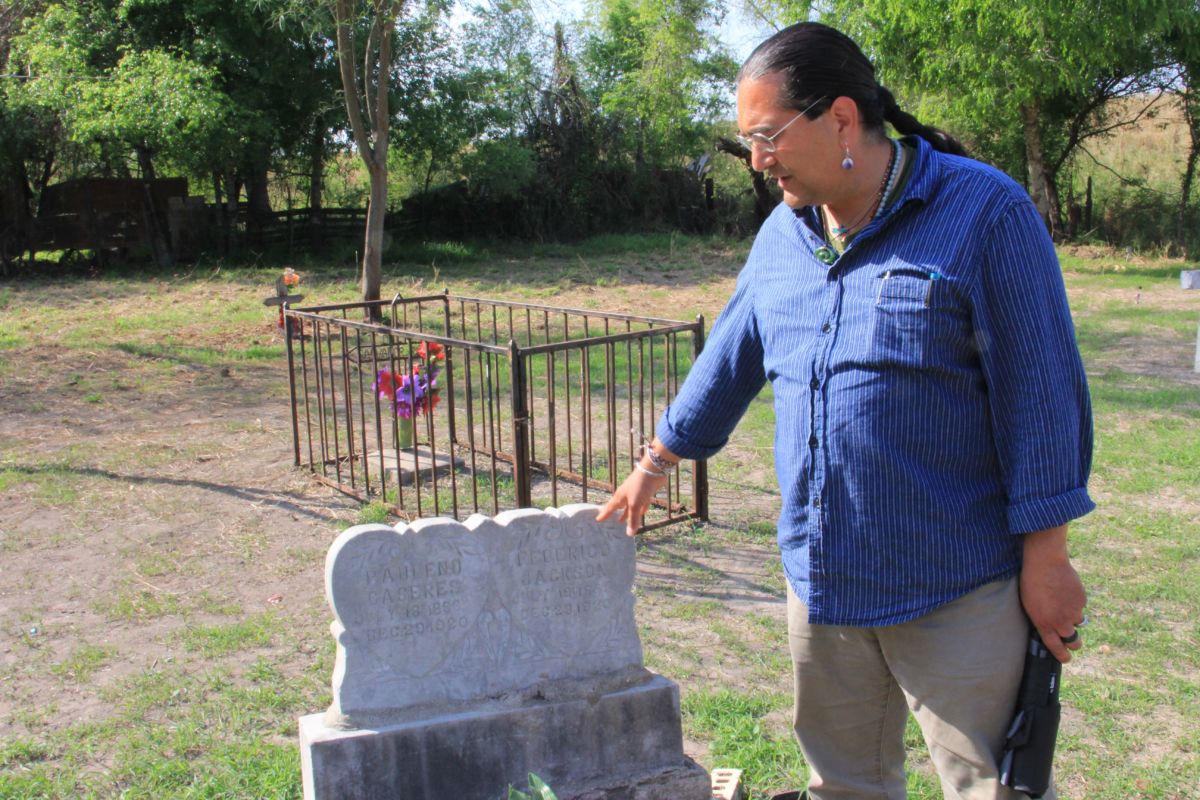
When it comes to the border wall, though, the “official stamp of approval” would mean little. NAGPRA is among the 28 federal environmental and preservation laws the Trump administration is sweeping aside under a provision of the 2005 REAL ID Act.
A Two-Front Fight
The fight for the tribal and environmental activists here, most of whom were born and raised in the Rio Grande Valley, is not just about the border wall. They are also steadfastly opposed to plans for three separate liquefied natural gas (LNG) export terminals in the Port of Brownsville that they say would turn their communities into sacrifice zones.
Like the border wall itself, the terminals’ proposed sites would cause irreparable damage to an important wildlife corridor critical to the survival of the endangered ocelot. The terminals’ emissions would also disproportionately impact the low-income majority-Latino communities in the Laguna Madre area of Brownsville, Texas.

For the Carrizo/Comecrudo tribe, though, the fight against LNG is more personal: One of the fracked gas companies, Texas LNG, which has planned its 600-acre fracked gas terminal since 2015, hopes to bulldoze a federally recognized Indigenous village and gravesite known as Garcia Pasture. The site contains remains of a pre-Columbian village and many other cultural artifacts from various nomadic cultures, including the Carrizo/Comecrudo. It is yet another sacred site under threat from colonial machinery.
Texas LNG wants “to try to find a way to say, ‘Well, you know, we want to build it right here,’ and they can’t. We’re not going to allow it. It’s not going to happen,” Mancias says of Garcia Pasture.
The tribe and its environmental-activist allies in groups like Save RGV from LNG and the Lower Rio Grande Valley Sierra Club successfully pressured BNP Paribas, the eighth largest bank in the world, to divest from the Texas LNG project in 2017.
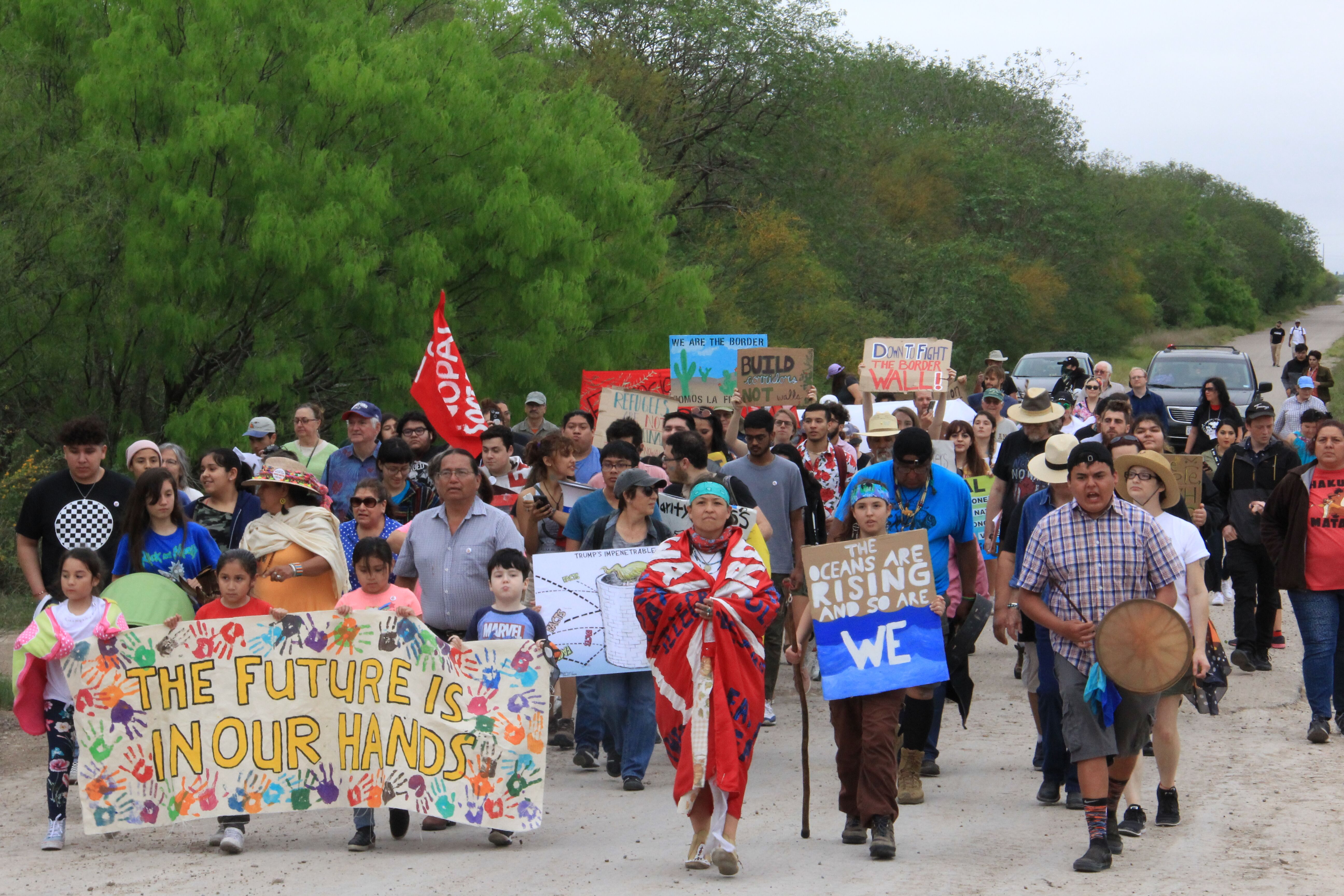
Indigenous resistance to cross-border fossil fuel infrastructure isn’t just taking place on the U.S. side. Mancias tells Truthout that the tribe is reaching out to Consejo Regional de Pueblos Originarios in Defensa del Territorio de Puebla y Hidalgo, an organization representing the Mexican Indigenous communities of Totonacos, Nahuas and Otomíes. These communities have successfully stalled TransCanada’s Tula-Tuxpan Pipeline, part of a pipeline system that includes the company’s cross-border Sur de Texas-Tuxpan Pipeline and the Enbridge-owned Valley Crossing Pipeline from Nueces County to Brownsville. The tribes have brought five separate legal challenges against the Tula-Tuxpan Pipeline and have sabotaged construction on another pipeline delivering natural gas from Arizona.
Texas LNG wants “to try to find a way to say, ‘Well, you know, we want to build it right here,’ and they can’t.”
The pipeline system’s South Texas end, Valley Crossing, is just one of several pipelines crossing under the state’s border. In fact, the New Burgos Pipeline will pass right under Trump’s border wall. The pipeline is slated to carry 108,000 barrels of gas and diesel per day under the wall between McAllen, Texas, and Reynosa, Tamaulipas, Mexico, and is a joint venture of NuStar Energy LP and PMI, affiliated with Mexico’s state-owned oil and gas company Petróleos Mexicanos.
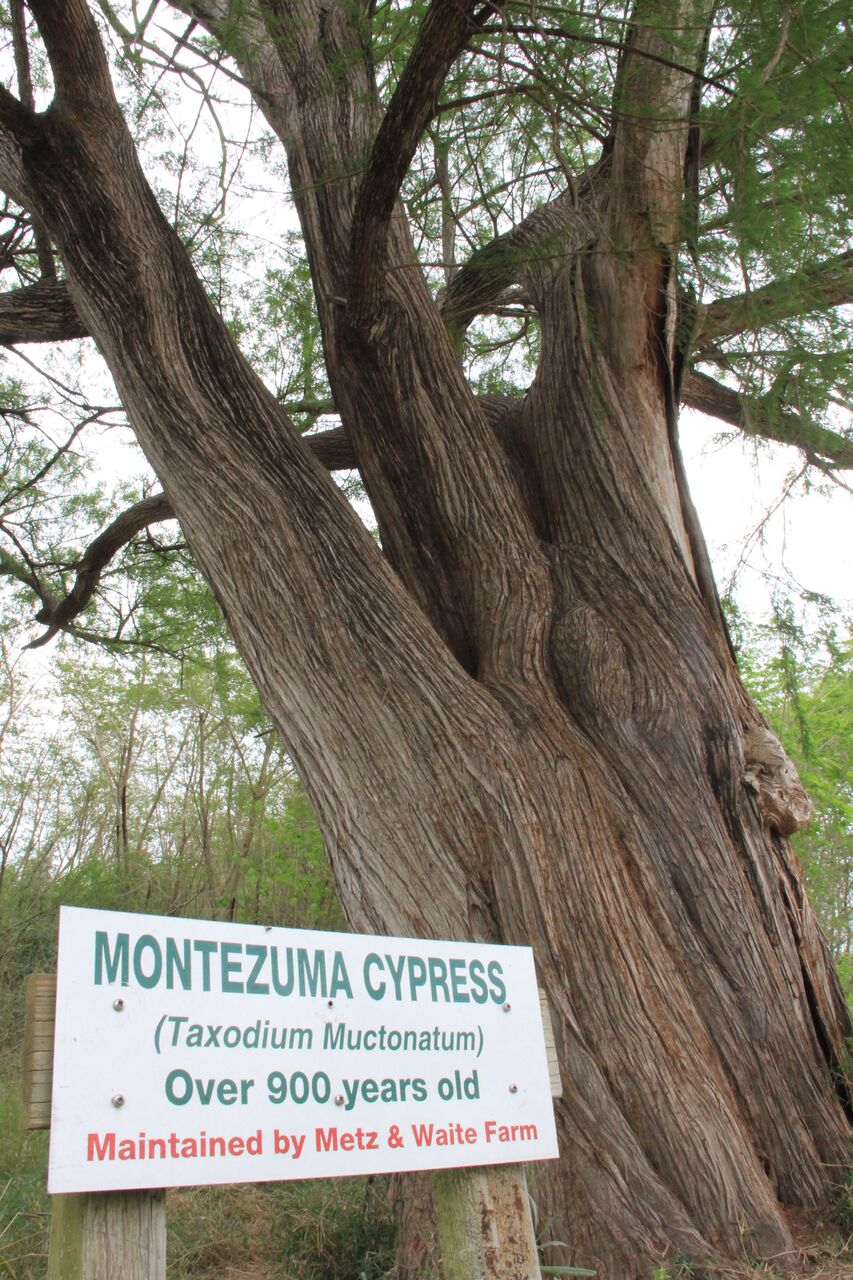
Meanwhile, Kinder Morgan is planning to expand the capacity of its Mier-Monterey gas pipeline. The pipeline stretches 90 miles from Monterrey, Mexico, into Starr County, Texas, which is slated to receive eight to 12 miles of new border wall. Mier-Monterey and New Burgos are joined by the Trans-Pecos, Comanche Trail, Roadrunner Phase II and Nueva Era pipelines, all delivering natural gas across the border to Mexico.
Trump has touted the New Burgos Pipeline as a boon to “American energy exports.” Marianna Treviño-Wright, executive director of the National Butterfly Center in Mission, worries that the administration’s waiving of federal environmental laws could lead to further buildout of fossil fuel infrastructure between the wall and the Rio Grande River.
“Once they get all the [LNG] terminals built at the Gulf, and they’re able to put the wall in from West Texas all the way to the Laguna Madre, no one will be able to get back there to really observe or object to the infrastructure that they put in,” Treviño-Wright tells Truthout. She fears the same environmental regulations that have been waived for the wall could also be waived for oil and gas infrastructure behind the wall in the name of national security.
Dismantling Borders
The tribe’s occupation of the Eli Jackson Cemetery is not just about resisting Trump’s border wall and energy export plans but also resisting the very idea of colonial borders that make corporate extraction of Native lands possible.
“Colonization has always been modern in the sense that it has always included corporate interests, private interests fueled by greed, approved by and sometimes protected by the militaries of nation-states,” Basaldú tells me.
The tribe’s occupation of the cemetery is not just about resisting Trump’s border wall; it’s about resisting the very idea of colonial borders.
That the Esto’k Gna are living once again in their sacred homelands along the Rio Grande, for him, is “in and of itself is resistance to fascism; it’s resistance to colonization; it’s resistance to global capital neoliberalism; it’s resistance to all these forms of power and greed that intersect in such a way as to destroy the humanity of human beings by reducing them to subjects of law enforcement or subjects of consumer capital.”
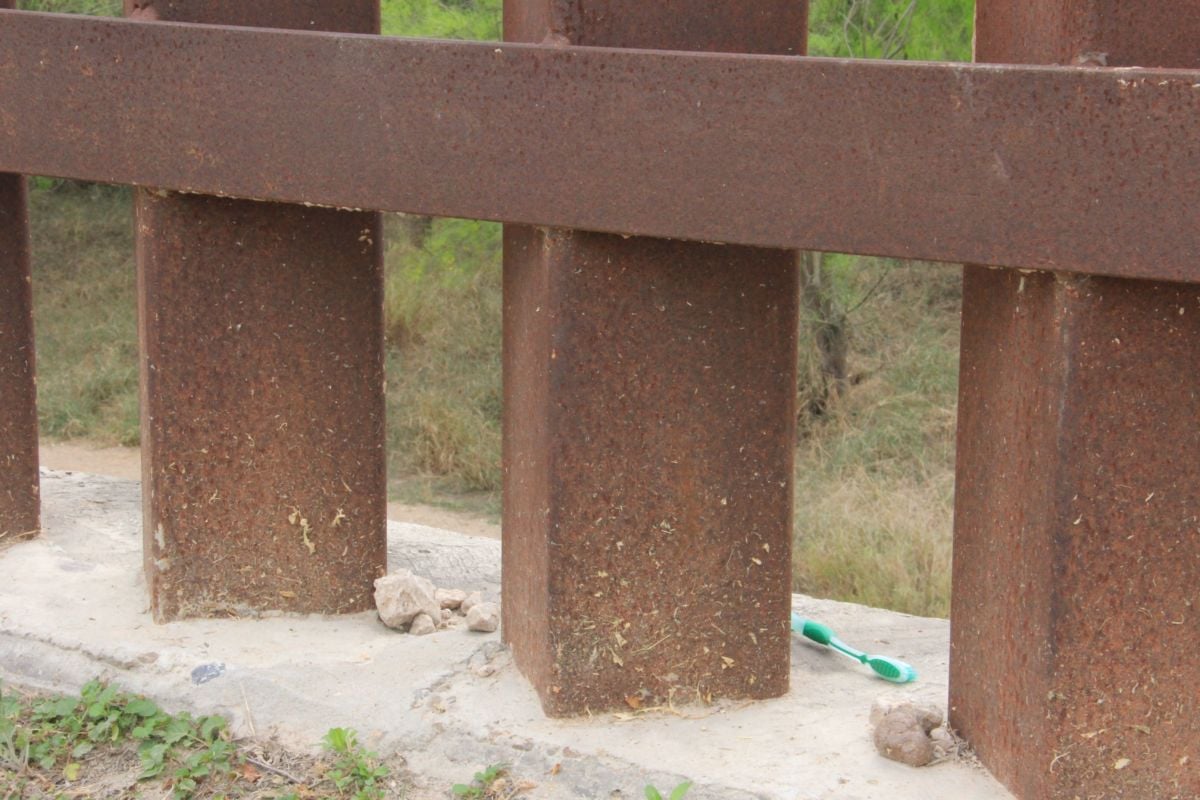
The river is “like a road. It’s what’s actually facilitated travel. It facilitated contact, between families, between villages, between clans,” Basaldú says. Without a wall and the Border Patrol security apparatus, the river would once again facilitate what Mancias calls asylum seekers’ inherent right to migrate.
“If whites have an inherent right to come from Europe, here, then there has to be a process for people of color to petition for asylum,” Mancias says. This includes Indigenous asylum seekers fleeing the fallout of the long legacy of U.S. state-sponsored genocidal campaigns, including the U.S.-backed Guatemalan military murders of tens of thousands of Maya in the 1980s.
“My spirituality lies in the sweat, the blood and the tears, and the pain and the anguish, and every stressful moment of occupation,” Mancias says.
Media that fights fascism
Truthout is funded almost entirely by readers — that’s why we can speak truth to power and cut against the mainstream narrative. But independent journalists at Truthout face mounting political repression under Trump.
We rely on your support to survive McCarthyist censorship. Please make a tax-deductible one-time or monthly donation.
